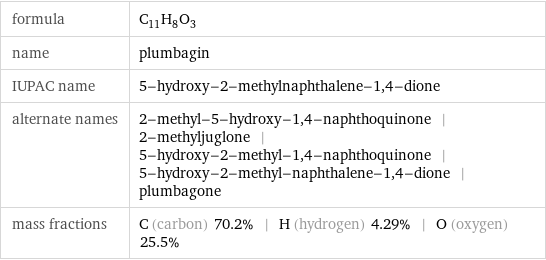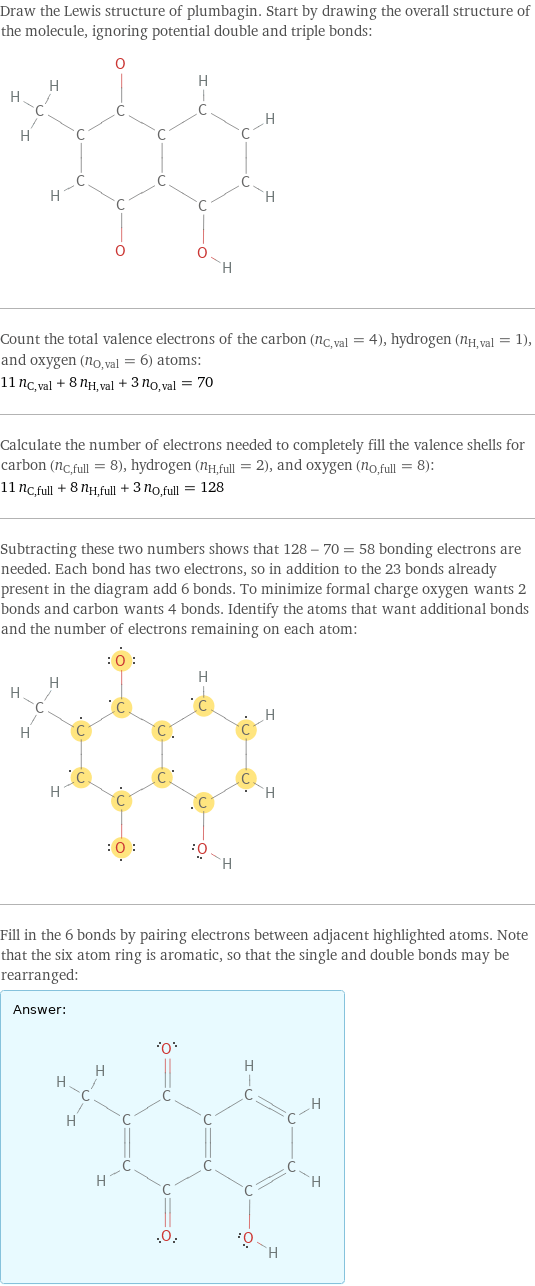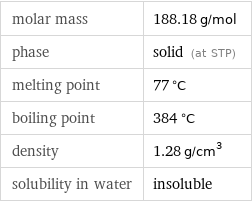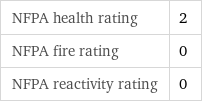Input interpretation

plumbagin
Chemical names and formulas

formula | C_11H_8O_3 name | plumbagin IUPAC name | 5-hydroxy-2-methylnaphthalene-1, 4-dione alternate names | 2-methyl-5-hydroxy-1, 4-naphthoquinone | 2-methyljuglone | 5-hydroxy-2-methyl-1, 4-naphthoquinone | 5-hydroxy-2-methyl-naphthalene-1, 4-dione | plumbagone mass fractions | C (carbon) 70.2% | H (hydrogen) 4.29% | O (oxygen) 25.5%
Lewis structure

Draw the Lewis structure of plumbagin. Start by drawing the overall structure of the molecule, ignoring potential double and triple bonds: Count the total valence electrons of the carbon (n_C, val = 4), hydrogen (n_H, val = 1), and oxygen (n_O, val = 6) atoms: 11 n_C, val + 8 n_H, val + 3 n_O, val = 70 Calculate the number of electrons needed to completely fill the valence shells for carbon (n_C, full = 8), hydrogen (n_H, full = 2), and oxygen (n_O, full = 8): 11 n_C, full + 8 n_H, full + 3 n_O, full = 128 Subtracting these two numbers shows that 128 - 70 = 58 bonding electrons are needed. Each bond has two electrons, so in addition to the 23 bonds already present in the diagram add 6 bonds. To minimize formal charge oxygen wants 2 bonds and carbon wants 4 bonds. Identify the atoms that want additional bonds and the number of electrons remaining on each atom: Fill in the 6 bonds by pairing electrons between adjacent highlighted atoms. Note that the six atom ring is aromatic, so that the single and double bonds may be rearranged: Answer: | |
3D structure

3D structure
Basic properties

molar mass | 188.18 g/mol phase | solid (at STP) melting point | 77 °C boiling point | 384 °C density | 1.28 g/cm^3 solubility in water | insoluble
Units

Solid properties (at STP)

density | 1.28 g/cm^3 vapor pressure | 2×10^-6 mmHg (at 25 °C)
Units

Thermodynamic properties

molar heat of vaporization | 65.7 kJ/mol specific heat of vaporization | 0.349 kJ/g (at STP)
Chemical identifiers

CAS number | 481-42-5 PubChem CID number | 10205 SMILES identifier | CC1=CC(=O)C2=C(C1=O)C=CC=C2O InChI identifier | InChI=1/C11H8O3/c1-6-5-9(13)10-7(11(6)14)3-2-4-8(10)12/h2-5, 12H, 1H3 RTECS number | QL8500000 MDL number | MFCD00001682
NFPA label

NFPA label

NFPA health rating | 2 NFPA fire rating | 0 NFPA reactivity rating | 0
Safety properties

flash point | 200 °C

DOT hazard class | 6.1 DOT numbers | 3143
Toxicity properties

RTECS classes | mutagen | reproductive effector